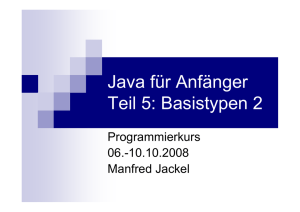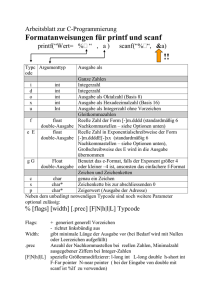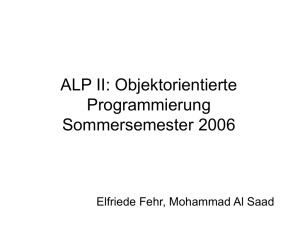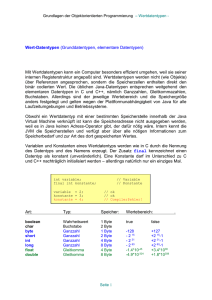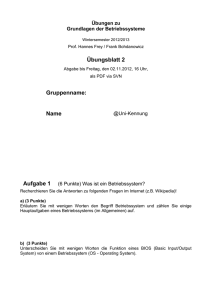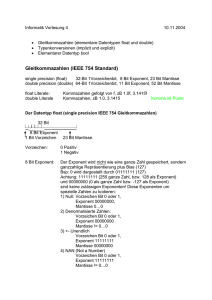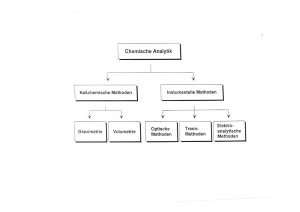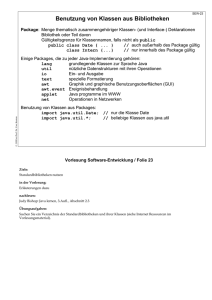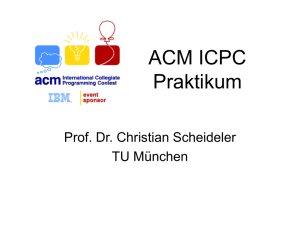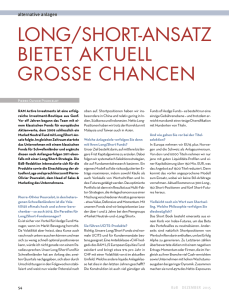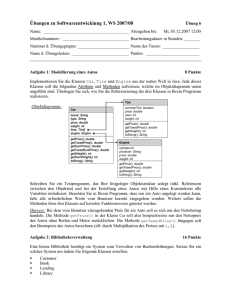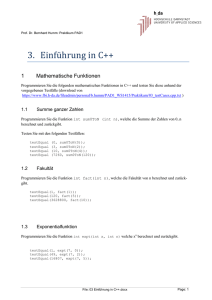olien 05
Werbung
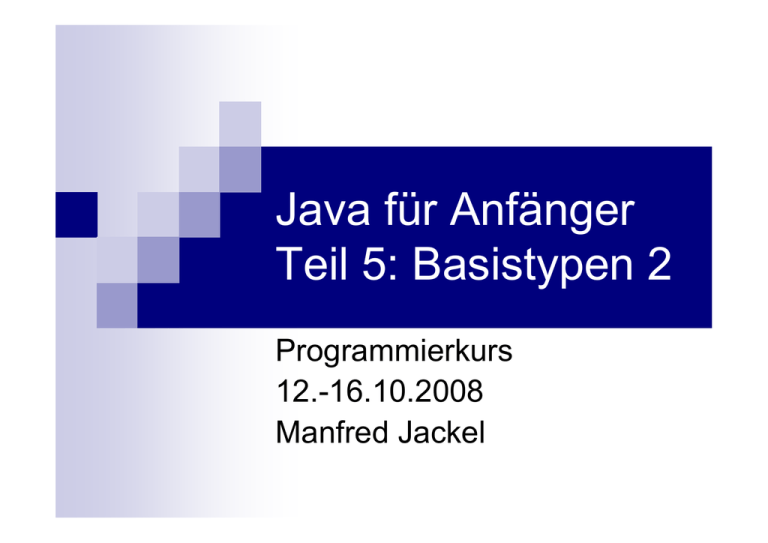
Java für Anfänger
Teil 5: Basistypen 2
Programmierkurs
12.-16.10.2008
Manfred Jackel
Char, String, Unicode
Der Zeichentyp char ist ein integraler Typ, nicht
vorzeichenbehaftet, kann alle Unicode-Zeichen
(Unicode 1) darstellen,´.
Literale des Typs char:
‘A‘,‘B‘,‘C‘ einfache
Tüttelchen, “A“ ist ein String-
Literal!
\b, \t, \n, \f,\r, \‘, \“, \\, \ooo
Rückschritt, Tabulator, Zeilenschaltung,
Seitenvorschub, Rückschritt, einfaches Apostroph,
doppeltes Apostroph, 3-stellige Oktalzahl <= 0377
\uxxxx Unicode-Zahlwert, Hexadezimalwert
\u0…\ufff
Datentyp char
Schlüsselwort char
char einBuchstabe;
einBuchstabe = ‘a‘;
einBuchstabe = \b; // Rückschritt
einBuchstabe = \ua; // Rückschritt
einBuchstabe = \u000a; // Rückschritt
\u0…\uff sind die Zeichen nach ISO 8859‐1
‘a‘<‘b‘, Vergleichsoperation
Numerische Datentypen
Bereits bekannt: Ganzzahlige oder integrale
Typen byte, short, int, long
Fließkommazahlen nach IEEE-754
float
(einfach Genauigkeit
Float.MIN_VALUE betragsmäßig kleinste Zahl !=0.0
Float.MAX_VALUE größte Zahl
double
(doppelte Genauigkeit)
Double.MIN_VALUE, Double.MAX_VALUE
Fließkomma-Literalte
FloatingPointLiteral::=
( Digits '.' [ Digits ] | '.' Digits ) [ Exponent ] [ FloatSuffix ] |
Digits ( Exponent [ FloatSuffix ] | [ Exponent ] FloatSuffix )
Digits::=
DIGIT { DIGIT }
Exponent::=
( 'e' | 'E' ) [ '+' | '-' ] Digits
FloatSuffix::=
'f' | 'F'| 'd' | 'D'
Fließkomma-Literalte
FloatingPointLiteral::=
( Digits '.' [ Digits ] | '.' Digits ) [ Exponent ] [ FloatSuffix ] |
Digits ( Exponent [ FloatSuffix ] | [ Exponent ] FloatSuffix )
0.
.0
1.2f
2.3d
3.4e56
6.7E-8d
1E-1
1d
1f
E
Ganze
Exp
e
d
0
1
2
D
Suffix
f
F
9
Fließkommazahl
+
Ganze
.
Ganze
Exp
Ganze
Suffix
.
Ganze
+
Ganze
Exp
Ganze
Suffix
Ganze
Suffix
-
+
Exp
-
Rechnen mit Gleitkomma
Gleitkommaberechnungen sind nicht exakt!
Interne Darstellung mit endlich langer Mantisse
Kommutativität, Assoziativität, Distributivität gelten nicht!
Beispiel: Quadratwurzel berechnen nach dem Newton-Verfahren
Gesucht x=Wurzel(n)
Suche eine Näherung q>0
q=x Î fertig!
q<x Î qx<x²=nÎx<n/q
zusammen q<x<n/q Wähle neue Näherung Mittel von q und n/q
qÍ(n+q²)/2q
q>x entsprechend
Abbruch wenn abs(q²-n) klein genug
Verträglichkeit vonTypen
Java ist streng typisierend bei den Basistypen
Zwei Typen sind gleich, wenn sie den gleichen
Namen haben.
Eine Variable kann nur Werte ihres eigenen Typs
annehmen.
Prüfung zur Compilezeit
Beispiel:
long l=123456789012;
int i;
i=l; // Compilerfehler!
Zuweisungen numerischer Typen
Eine Zuweisung l=i; wäre sinnvoll!
Java ist vernünftig! l=i; ist o.k.
Es gibt implizite (automatische) und explizite
Typumwandlungen
bei
numerischen Datentypen wird automatisch
konvertiert, wenn keine Bereichsprobleme auftreten ,
Zuweisungen numerischer Typen
byte b;
short s;
int i;
long l;
float f;
double d;
d = f = l = i =s =b;
in dieser Kette treten keine
Bereichs- oder
Genauigkeitsprobleme auf
Erzwungene, explizite Typumwandlung zwischen integralen Typen:
i = (int)l;
b = (byte)s; ;;
Typecast, Typkonvertierung durch Operator „(typename)“
Widening conversions
The following 19 specific conversions on
primitive types are called the widening primitive
conversions:
byte to short, int, long, float, or double
short to int, long, float, or double
char to int, long, float, or double
int to long, float, or double
Implizite
long to float or double
Typumwandlung
float to double
Narrowing conversions
The following 23 specific conversions on primitive types
are called the narrowing primitive conversions:
byte to char
short to byte or char
Fehler sind
char to byte or short
möglich!
int to byte, short, or char
long to byte, short, char, or int
float to byte, short, char, int, or long
double to byte, short, char, int, long, or float
Fließkomma ist ungenau!
class Test { public static void main(String[] args) {
int big = 1234567890;
float approx = big; System.out.println(big ‐ Aufgabe: Ermittle
(int)approx); } kleinste int-Zahl,
die nicht exakt als
}
float dargestellt
wird
Ausgabe
-46
Gemischte numerische
Ausdrücke;
Darf man gemischte Ausdrücke
schreiben?
long l; int i;
l+i ?
Kann verwendet werden
Automatiwsche
Widening Conversion nach
long.
b+s+i+l+f+d entspricht ((((b+s)+i)+l)+d)+f
Hüllklassen (Wrapper)
Zu jedem Basistyp gibt es eine Hüllklasse mit nützlichen
Werten und Funktionen
Name: Name des Basistyps in Großschreibung, fast(!)
Byte, Short, Integer, Long, Float, Double
Integer.MAX_VALUE, INTEGER.MIN_VALUE
Integer.ToString(014) == “12“;
Integer.parseInt(“ -1“) == -1
http://java.sun.com/j2se/1.4.2/docs/api/index.htm
l
Die Klasse Math
Die Klasse
Math stellte
viele
Funktionen
und
Konstanten für
numerische
Berechnungen
bereit.
java.lang.Integer
Methoden
